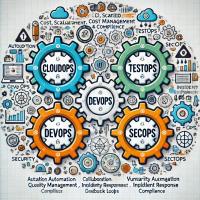CloudOps vs DevOps vs TestOps vs SecOps - Comparison and Differences

Understanding CloudOps vs. DevOps vs. TestOps vs. SecOps
Introduction
In the realm of modern IT and software development, several methodologies have emerged to streamline processes, improve efficiency, and enhance security. CloudOps, DevOps, TestOps, and SecOps are four key operational approaches that organizations leverage to achieve these goals. Each serves a unique purpose and addresses specific needs within the IT infrastructure and development lifecycle.
CloudOps
CloudOps (Cloud Operations) focuses on the operational management of cloud environments. As businesses migrate to the cloud, managing cloud resources efficiently becomes paramount. CloudOps ensures that cloud services are delivered consistently and optimally.
Key Features:
- Automation: Automates cloud infrastructure management to reduce manual intervention and errors.
- Scalability: Facilitates scaling of resources up or down based on demand.
- Cost Management: Monitors and optimizes cloud expenditure to prevent overspending.
- Compliance: Ensures that cloud operations adhere to regulatory and security standards.
DevOps
DevOps (Development Operations) bridges the gap between development and IT operations. It emphasizes collaboration, communication, and integration between software developers and IT professionals to enhance the speed and quality of software delivery.
Key Features:
- Continuous Integration/Continuous Deployment (CI/CD): Enables frequent and reliable code integration and deployment.
- Collaboration: Promotes teamwork and collaboration between developers and operations teams.
- Automation: Automates repetitive tasks to accelerate development processes.
- Monitoring and Feedback: Continuously monitors applications in production and provides feedback for improvement.
TestOps
TestOps (Testing Operations) integrates testing into the DevOps pipeline. It focuses on automating and managing the testing process to ensure software quality and reliability throughout the development lifecycle.
Key Features:
- Test Automation: Automates test execution to speed up the testing process.
- Continuous Testing: Incorporates testing at every stage of the development process.
- Quality Assurance: Ensures that software meets the required quality standards before deployment.
- Feedback Loops: Provides timely feedback to developers on test results and issues.
SecOps
SecOps (Security Operations) integrates security practices into the IT operations framework. It aims to enhance security posture by embedding security measures into every stage of the IT lifecycle.
Key Features:
- Security Automation: Automates security tasks such as threat detection and response.
- Vulnerability Management: Continuously identifies and mitigates vulnerabilities.
- Incident Response: Provides a structured approach to respond to and recover from security incidents.
- Compliance: Ensures adherence to security policies, standards, and regulations.
Comparison and Integration
While CloudOps, DevOps, TestOps, and SecOps have distinct focuses, they often overlap and integrate within modern IT environments. For instance:
- DevOps and TestOps work closely to ensure that testing is an integral part of the development cycle, leading to faster and higher quality releases.
- CloudOps and DevOps collaboration enables seamless deployment and management of applications in cloud environments.
- SecOps integrates with both DevOps and CloudOps to embed security practices into development and cloud management processes, ensuring robust security throughout.
Conclusion
CloudOps, DevOps, TestOps, and SecOps each play a critical role in the contemporary IT landscape. Understanding their unique functions and how they interrelate is essential for organizations aiming to optimize their operations, enhance software quality, and maintain robust security. By integrating these practices, businesses can achieve greater agility, efficiency, and resilience in their IT operations.







